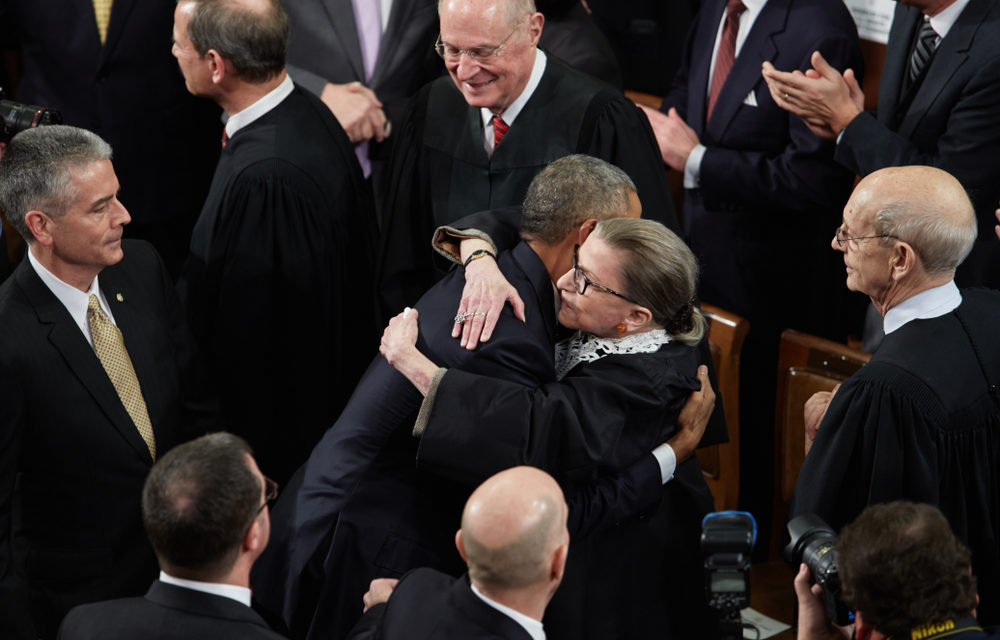Justice Ruth Bader Ginsburg, Champion Of Gender Equality, Dies At 87
Justice Ruth Bader Ginsburg died on Friday of “complications of metastatic pancreas cancer,” the Supreme Court announced. She was 87.
The woman who seemed indestructible died at home surrounded by family.
“Our nation has lost a jurist of historic stature,” Chief Justice John G. Roberts Jr. said in a statement. “We at the Supreme Court have lost a cherished colleague. Today we mourn, but with confidence that future generations will remember Ruth Bader Ginsburg as we knew her — a tireless and resolute champion of justice.”
Justice Ginsburg is revered in liberal circles, with her many fans calling her Notorious R.B.G., a nod to the rapper Notorious B.I.G. The justice has embraced the connection. “We were both born and bred in Brooklyn, New York,” she likes to say, according to the New York Times.
Less than 100 pounds and under 5 feet tall, she fought for gender equity and carried herself with dignity. She spoke slowly and deliberately and was known for putting people at ease. Though small in stature, she was a formidable women’s rights champion who became the court’s second female justice,
Justice Ginsburg, who is 87, had repeatedly vowed to stay on the court as long as her health held and she stayed mentally sharp. “I have often said I would remain a member of the court as long as I can do the job full steam,” she said in July, announcing a recurrence of cancer. “I remain fully able to do that.”
The discovery of lesions on her liver in May was only her most recent medical setback. She has had surgery for lung cancer and radiation treatment for pancreatic cancer in recent years. She has also had surgery for early-stage pancreatic cancer in 2009 and treatment for colon cancer in 1999.
She was appointed to the court by President Bill Clinton in 1993. At recent arguments, she asked probing questions based on an assured command of the pertinent legal materials and factual record.
During the Obama administration, some liberals urged Justice Ginsburg to step down so that President Barack Obama could name her successor. She rejected the advice.
In the words of Ruth Bader Ginsburg, Supreme Court Justice and co-founder of the Women’s Rights Project at the ACLU, “Women’s rights are an essential part of the overall human rights agenda, trained on the equal dignity and ability to live in freedom all people should enjoy.”
Ginsburg was a pioneer for gender equality throughout her distinguished career. While singular in her achievements, she was far from alone in her pursuits and received much support from talented, dedicated women all along the way. Celia Bader provided a strong role model for her daughter at an early age. Ginsburg recalls, “My mother told me two things constantly. One was to be a lady, and the other was to be independent. The study of law was unusual for women of my generation. For most girls growing up in the ’40s, the most important degree was not your B.A., but your M.R.S.”
Ginsburg famously lamented the Supreme Court’s reasoning in its 1973 Roe v. Wade opinion, which grounded abortion rights in a constitutional right to privacy rather the principle of equal protection.
While she staunchly defended reproductive rights, Ginsburg believed the Court had gone too far, too fast, putting forward a “grand philosophy” at a time when many states were taking steps to “liberalize” abortion laws on their own.
By the time she was in her 80s, she had become something of a rock star to women of all ages. She was the subject of a hit documentary, a biopic, an operetta, merchandise galore featuring her “Notorious RBG” moniker, a Time magazine cover, and regular Saturday Night Live sketches.
She was critical of Mr. Trump during the 2016 campaign, and he responded that “her mind is shot” and said she should resign. She later said she had made a mistake in publicly commenting on a candidate and promised to be more “circumspect” in the future.
Ginsburg’s death gives Republicans the chance to tighten their grip on the court with another Trump appointment so conservatives would have 6-to-3 majority.
Image Sources
- Ruth Bader Ginsburg: Shutterstock







